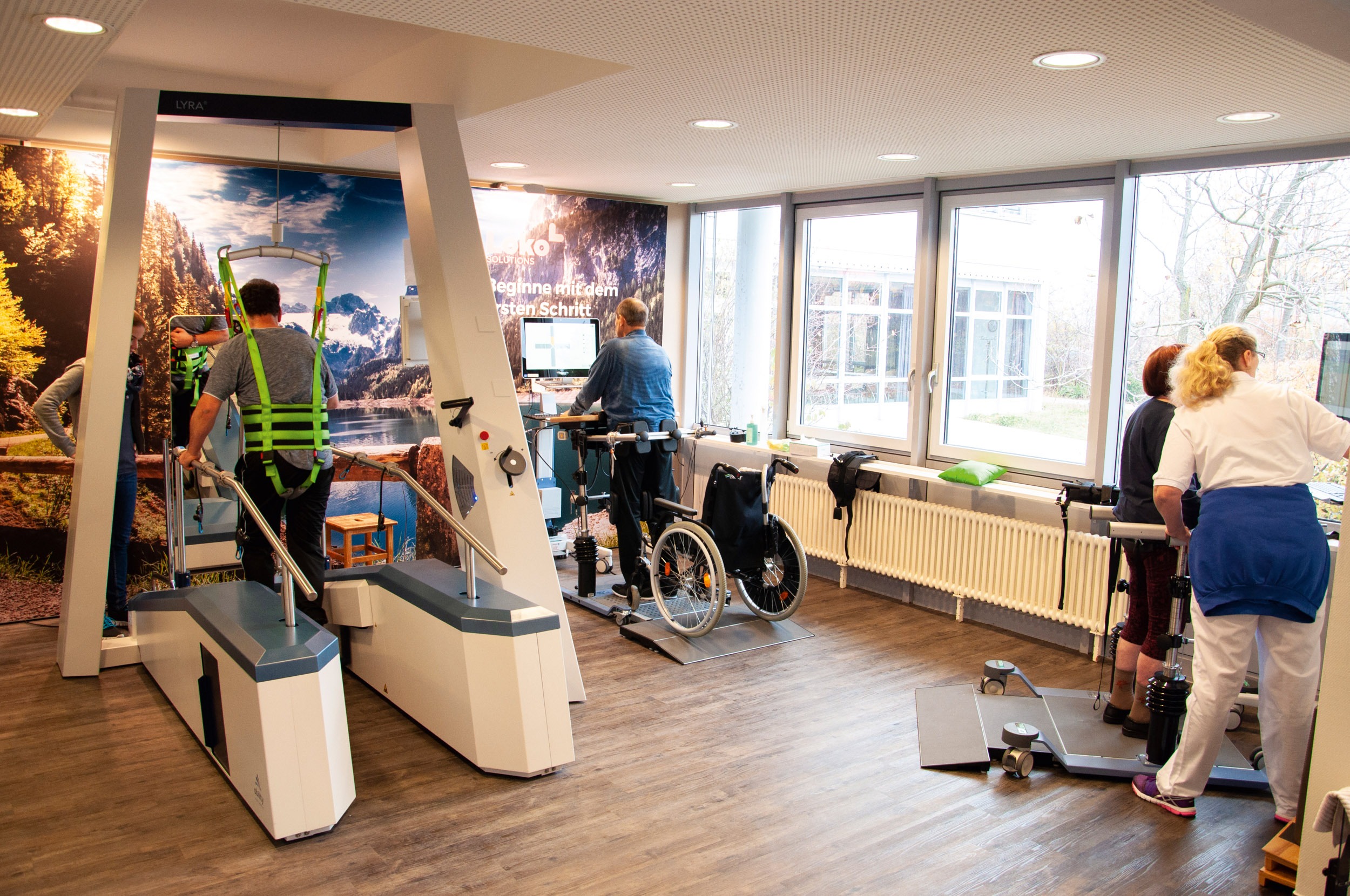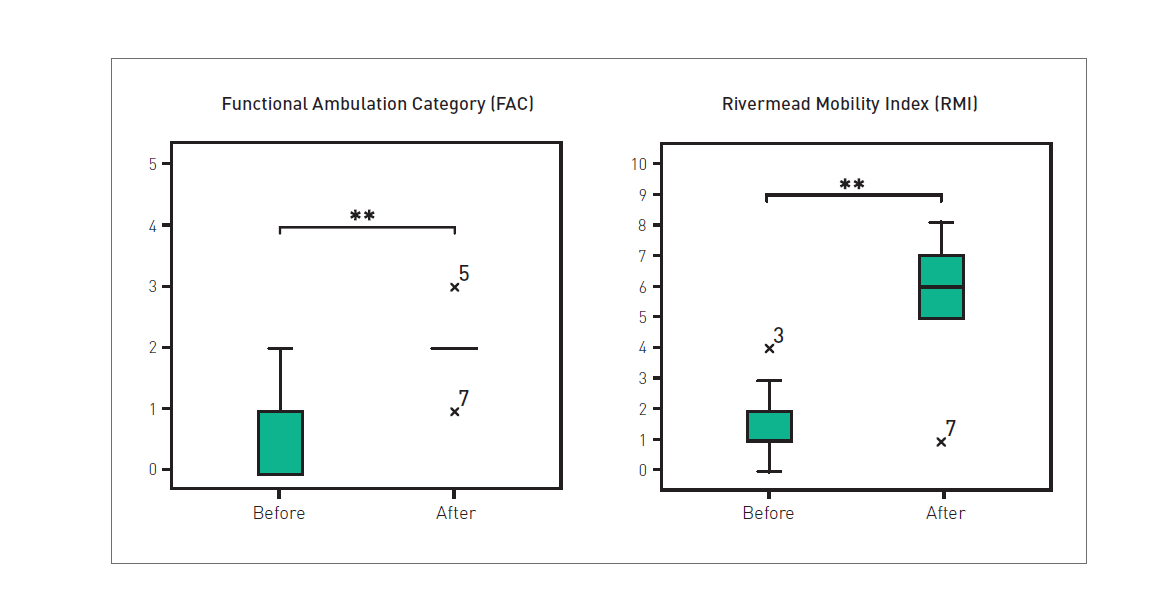
A pilot study from MEDIAN Klinik Magdeburg shows that device-based circuit therapy significantly improves walking ability in patients with severe neurological impairments. High patient acceptance and reduced therapist workload make it a promising rehab model.

One of the most important goals in neurological rehabilitation is the recovery and/or improvement of walking ability in most patients [1]. The success of physiotherapy measures within gait rehabilitation is fundamentally associated with a large number of repetitions and high treatment intensity. This is also confirmed in the latest German guideline for rehabilitation of mobility after stroke [2].
But there are two key reasons that make it difficult for service providers to ensure a large number of repetitions. Achieving the specified therapy time and frequency is barely possible in practice. Therapy frequency would have to be increased accordingly while budgets remain the same. In addition, therapists who treat patients with severe neurological damage are exposed to a high level of physical strain during gait training [2]. In order to compensate for this and to ensure patient safety, therapy is sometimes only possible with two therapists per patient. Gait rehabilitation therefore requires a significant level of staffing, and it is both expensive and time-consuming.
If adding device-based circuit therapy to enhance physiotherapy treatment without impacting treatment quality were to succeed in this context, this would benefit patients, the rehabilitation facility and the therapists involved. A new approach is therefore to increase the therapy frequency and intensity using device-based circuit therapy. The therapist is then in a position to look after several patients. This reduces staffing requirements and helps translate therapeutic recommendations into practice. The question remains as to whether device-based circuit therapy in conjunction with slightly reduced individual physiotherapy is effective. There is currently no valid data to support this.
To analyse this question, data was collected at the MEDIAN Klinik NRZ in Magdeburg where treatment using device-based circuit therapy has been provided since 2017. The circuit in Magdeburg consists of two balance trainers, an end-effector gait trainer and four movement exercisers. Training takes place two to three times a week for 90 minutes with two physiotherapists on hand. This means that up to five patients can improve their walking ability using device-based circuit therapy in a group setting.
The sample included 10 patients. Training progress was assessed using the Functional Ambulation Categories (FAC) and the Rivermead Mobility Index (RMI). Both assessments were collected at admission to rehabilitation and at discharge. All patients in the study population were initially unable to walk.
A questionnaire was drawn up to record patient acceptance of device-supported circuit therapy in addition to medical effectiveness. The aim of the questionnaire was to present the subjective patient benefits from this form of therapy. The assumption behind the questionnaire was that patient acceptance comprises a number of aspects. Questions covering the fields of technology, mental state, effectiveness and social interaction were put together and analysed.
The following figure shows the improvements in FAC and RMI scores among the study population between admission to and discharge from rehabilitation.
An improvement in walking ability based on FAC data was already apparent in this small cohort. All patients improved by at least one category during the study period. At the time of admission, the study population was unable to walk and stand with a median of 0 (this is a statistical mean). With a median of 2 at discharge from rehabilitation, patients who were unable to stand and walk at the start could now walk with human assistance. This mobility improvement is also reflected in the RMI results. The RMI median at admission to rehabilitation was 1 and 5.5 on discharge.
In terms of subjective benefit from the patient perspective, the response distribution confirmed the hypotheses for the fields covering technology, mental state and effectiveness. Taken together, the general opinion is that the circuit devices are safe and stable, and that therapy is fun and helps recover walking ability. What could not be confirmed is the assumption that device-based circuit therapy is motivating through increased social interaction among patients.


- Hesse, S. et al. (2015): Das Lokomotionsstudio: eine effektive und effiziente Lokomotionstherapie in der Gruppe für Patienten der Phasen B, C und D der neurologischen Rehabilitation, in: Neurologie & Rehabilitation, 4/2015, S. 195-200.
- ReMoS Arbeitsgruppe (2015): S2e Leitlinie Rehabilitation der Mobilität nach Schlaganfall (ReMoS), in: Neurologie & Rehabilitation, 7/2015, S. 355-494.
Related contents
Find related exciting contents in our media library.
Meet our specialists.
Are you interested in our solutions? Schedule a meeting with a Consultant to talk through your strategy and understand how TEHRA-Trainer can help you to advance rehabilitation.
You need to load content from reCAPTCHA to submit the form. Please note that doing so will share data with third-party providers.
More InformationYou are currently viewing a placeholder content from Turnstile. To access the actual content, click the button below. Please note that doing so will share data with third-party providers.
More Information